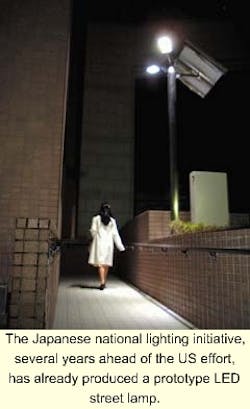Solid-state lighting expands as industry awaits illumination

The market for conventional light-emitting diodes (LEDs) has not grown significantly during the past five years, while the market for high-brightness LEDs grew 53% last year alone and has begun to rival the conventional market in size, according to comments by Robert Steele, director of optoelectronics programs at Strategies Unlimited (Mountain View, CA). Steele's market overview led off a 1½-day Strategies Unlimited conference on LED market opportunities in February. Despite impressive growth in this area, truly exponential growth, as well as major global energy savings, await the development of LED technology for general illumination. So national technology initiatives in the United States and Japan are in the offing to accelerate technology development.
In the year 2000 the total worldwide market for light-emitting diode LED components was $2.9 million, with high-brightness LEDs contributing $1.2 billion or 42%, and experiencing 53% growth over the previous year, Steele said. The market for conventional LEDs grew only 12%, which after a dip in the past few years simply returned it to 1995 and 1996 levels. Even though illumination offers the biggest market growth potential, it is currently one of the smallest pieces of the market pie for high brightness LEDs, comprising only 2%, along with traffic signals, which also contribute 2%. Currently, the major use sectors for high-brightness LEDs are electronic equipment (16%), automotive lighting (22%), display backlighting (27%), and signs (31%).
In 2000, the $585 million LED sign market accounted for 11% of the entire US market for electronic signs, but the primary growth was in full-color signs, which accounted for almost half the total LED sign market and grew more than 30% over 1999. Traffic signal replacements grew by more than 100% over 1999 to about 8% of the installed base in 2000, fueled in part by electric utility subsidy programs targeting reduced energy consumption. Use in automotive tail and signal lights jumped almost 20% over 2000, while automotive instrument panel lighting use climbed 45%. Extremely rapid growth in display backlighting last year was driven by a highly competitive Japanese market. Production for mobile phones with full-color displays in that market almost quintupled last year from 2 million to 9 million units.
Most of the conference was devoted to fleshing out the details of these high-growth markets. Two of the last three sessions focused on the potential of LED technology to compete strongly while providing significant energy savings in the general illumination market currently estimated at $3 billion in the United States and $12 billion worldwide.
Steve Johnson, group leader for the lighting research group at Lawrence Berkeley National Laboratory (Berkeley, CA) gave an update on the US-industry-driven and Department-of-Energy-funded Solid State Lighting Initiative. About 3.4 x 1015 kW-hrs were consumed in buildings in 1998, according to Johnson, and 17% of that, or about 600 trillion kW-hrs, was used for lighting. Commercial and industrial buildings accounted for 72% of that energy consumption. The lighting initiative hopes to direct government and industry funds to accelerate development of solid-state lighting technology to substantially reduce lighting energy consumption over the next 20 years. Currently, the initiative is considering both LED and organic LED technologies.
Johnson's comments focused on barriers between current LED technology and a proposed 150 lumen/Watt that would make LED technology strongly competitive with existing electrical lighting products. Those barriers ranged from establishing a domestic supply of substrates for producing solid-state lighting materials to addressing technological barriers in substrate performance, growth of epitaxial layers, photon conversion efficiency for generating white light, and packaging. The Optoeletronics Industry Development Association (OIDA; Washington, DC) is coordinating the initiative, Johnson said.
Japan
In Japan, lighting accounts for about 20% of all energy use, according to Tsunemasa Taguchi a professor of electrical engineering at Yamaguchi University, who addressed the conference about the Twenty-first Century Lighting Project in Japan, several years ahead of the Solid State Lighting Initiative in the United States. The Japanese effort grew out of a government decision in 1997 to reduce CO2 emissions caused by energy use by the year 2010 to their 1990 levels.
The lighting project is funded by the Japanese Ministry of Economy, Trade and Industry and carried out through the New Energy and Industrial Technology Development Organization (NEDO) and the Japan Research and Development Center for Metals (JRCM). Research foci to date include emission mechanisms in gallium nitride based compound semiconductors, epitaxial growth methods for blue and ultraviolet LEDs, large substrates for homoepitaxial growth, and white light sources
The project has already produced a prototype LED street lamp powered by a combination of solar cells and batteries that can operate at night without any external power supply (see photo, p. 87). The actual lamp consists of 700 ultrahigh-brightness, white LEDs within a clear 28 x 13 cm2 case. They consume 56 W of power at 24 V. Normal lamp brightness is set at 80 lx, which is increased to 660 lx by circuitry that senses motion within two meters of the lamp. The prototype is 46 times brighter than a white incandescent bulb with the same energy consumption, Taguchi said.
The ultimate aim of the Japanese project is to develop an LED replacement for incandescent and fluorescent lamps, Taguchi said. "The biggest potential application for white LEDs is in general lighting."
For more information on III-V light emitting diodes, see "new light from old sources," p. 133.
About the Author
Hassaun A. Jones-Bey
Senior Editor and Freelance Writer
Hassaun A. Jones-Bey was a senior editor and then freelance writer for Laser Focus World.